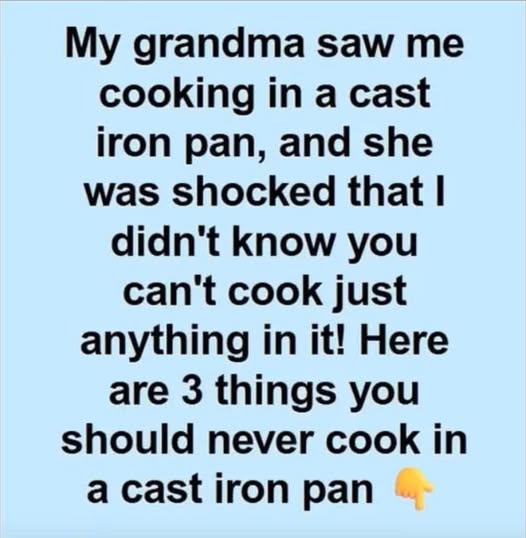What You Should Never Cook in a Cast Iron Skillet

Cast iron skillets are a beloved kitchen staple for good reason. Known for their durability, excellent heat retention, and timeless appeal, these pans can last for generations when properly cared for. From golden cornbread to sizzling steaks, a well-seasoned cast iron skillet brings flavor and character to countless dishes. But despite their versatility, there are a few foods that don’t belong in cast iron—and knowing what to avoid can protect your pan and your meals.
1. Acidic Foods
Tomatoes, vinegar-based sauces, and citrus-heavy dishes can be too harsh for cast iron. These ingredients may erode the seasoning and react with the iron, leaving behind a metallic taste. While a quick tomato sauté in a well-seasoned skillet might be fine, long-simmering dishes like stews or braises are better prepared in stainless steel or enameled cookware.
2. Delicate Fish
Flaky fish like tilapia, sole, or flounder often stick to cast iron’s textured surface. They can break apart easily and leave behind lingering odors that affect future dishes. For delicate seafood, a nonstick or stainless steel pan is a better option to maintain the integrity of the fish—and the flavor of your next meal.
3. Sugary Sauces
Sticky glazes like teriyaki, honey garlic, or sweet barbecue sauces tend to burn quickly in cast iron, making cleanup difficult and potentially damaging the seasoning. Unless your skillet has developed a very smooth, nonstick finish, it’s best to use nonstick pans for sugary sauces to avoid sticking and stubborn residue.
4. Eggs (for Beginners)
While cast iron pros can cook eggs with ease, newer users might struggle with sticking and frustration. Unless your pan is exceptionally well-seasoned and you’re confident in managing heat and oil, it’s best to stick with a nonstick skillet for scrambled eggs or omelets.
5. Pungent or Aromatic Foods
Strong flavors like garlic, onions, and spices used in curries or stir-fries can leave behind odors in cast iron. Since the pan retains flavors, you might notice a hint of your last savory dish when baking something sweet. Many cooks keep two pans: one for savory cooking and one dedicated to baked goods or desserts.
6. High-Moisture Cooking
Boiling pasta or steaming vegetables in cast iron can cause the seasoning to break down and may even lead to rust over time. Cast iron thrives on dry, even heat—not prolonged exposure to water. For moisture-heavy recipes, choose stainless steel or enameled pots instead.
7. Storing Leftovers
Leaving food in the skillet after cooking can cause rust or strip away the seasoning, especially if the food is acidic or moist. Always transfer leftovers to a separate container once the dish has cooled, then wash and dry your skillet promptly.
8. Thermal Shock
Pouring cold water into a hot cast iron skillet can cause the metal to warp or even crack. Similarly, placing cold food into a very hot pan can cause uneven cooking and stress the metal. Always let your skillet cool naturally before cleaning, and avoid sudden temperature changes.
Tips for Long-Lasting Cast Iron
Clean gently: Avoid harsh soaps and scrubbers unless necessary.
Dry thoroughly: Water is the enemy of cast iron—dry it right away.
Re-season often: After cleaning, apply a light coat of oil to maintain the nonstick surface.
Store smart: Keep your skillet in a dry, well-ventilated place to prevent rust.
With the right care and thoughtful cooking choices, your cast iron skillet can be a kitchen companion for decades. By avoiding common mistakes and giving it regular TLC, you’ll ensure it stays in top shape—and continues to enhance your meals for years to come.
